Human Capital Development in Tourism: Challenges and Strategies
VerifiedAdded on 2022/11/19
|9
|2400
|213
Report
AI Summary
This report examines the human capital development challenges within the tourism sector, specifically addressing labor shortages in British Columbia and beyond. It identifies key HR issues, including demographic shifts like lower birth rates and an aging population, the industry's perceived weaknesses in salary and career progression, and mismatches between skilled labor supply and demand. The report further explores strategies to combat these challenges, such as state workforce investment boards, the use of temporary service workers, and the potential of international workers to fill skill gaps. It highlights the importance of these strategies in ensuring the continued growth and success of the tourism industry, emphasizing the need for proactive human resource management to overcome labor shortages and retain quality employees.
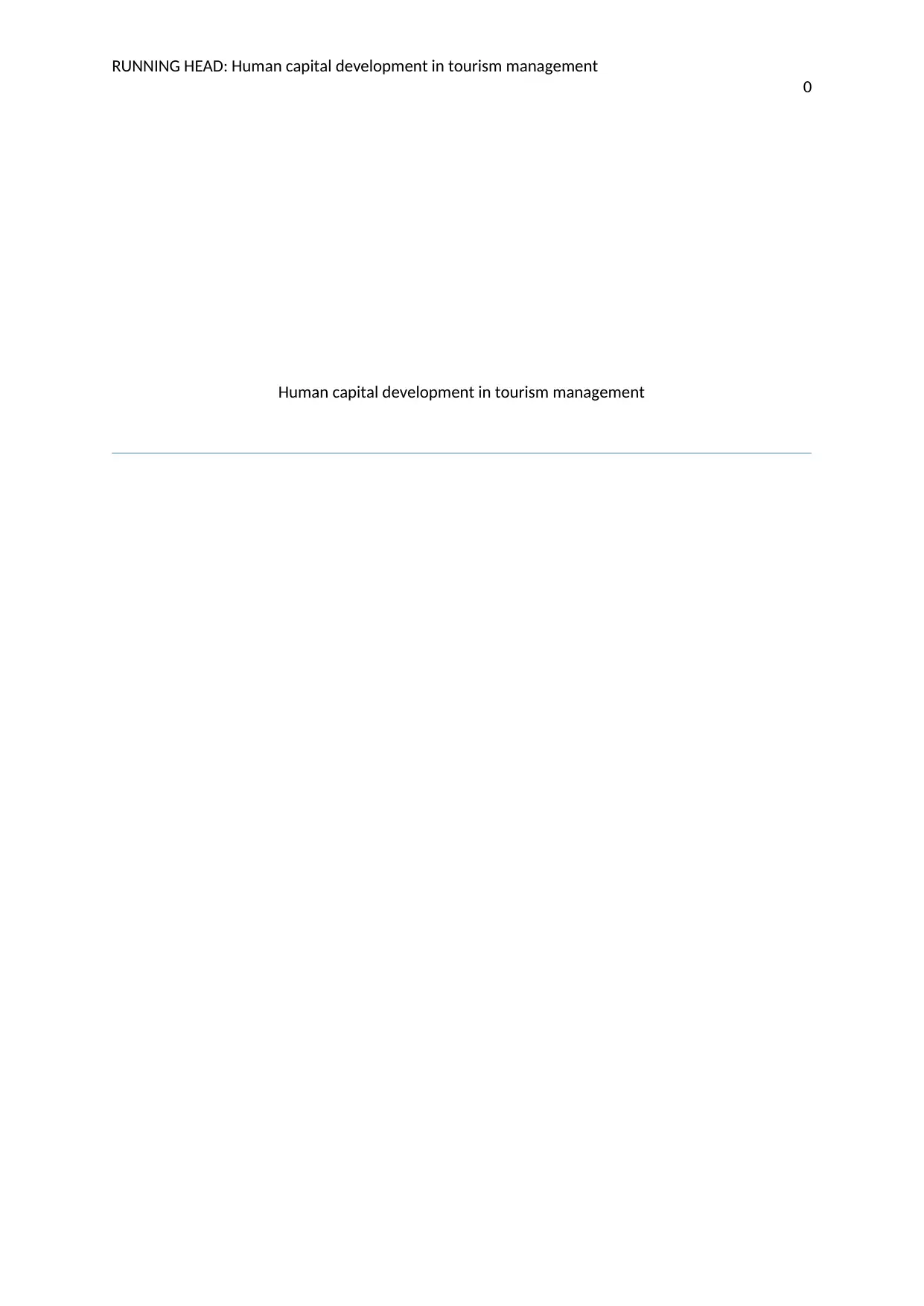
RUNNING HEAD: Human capital development in tourism management
0
Human capital development in tourism management
0
Human capital development in tourism management
Paraphrase This Document
Need a fresh take? Get an instant paraphrase of this document with our AI Paraphraser
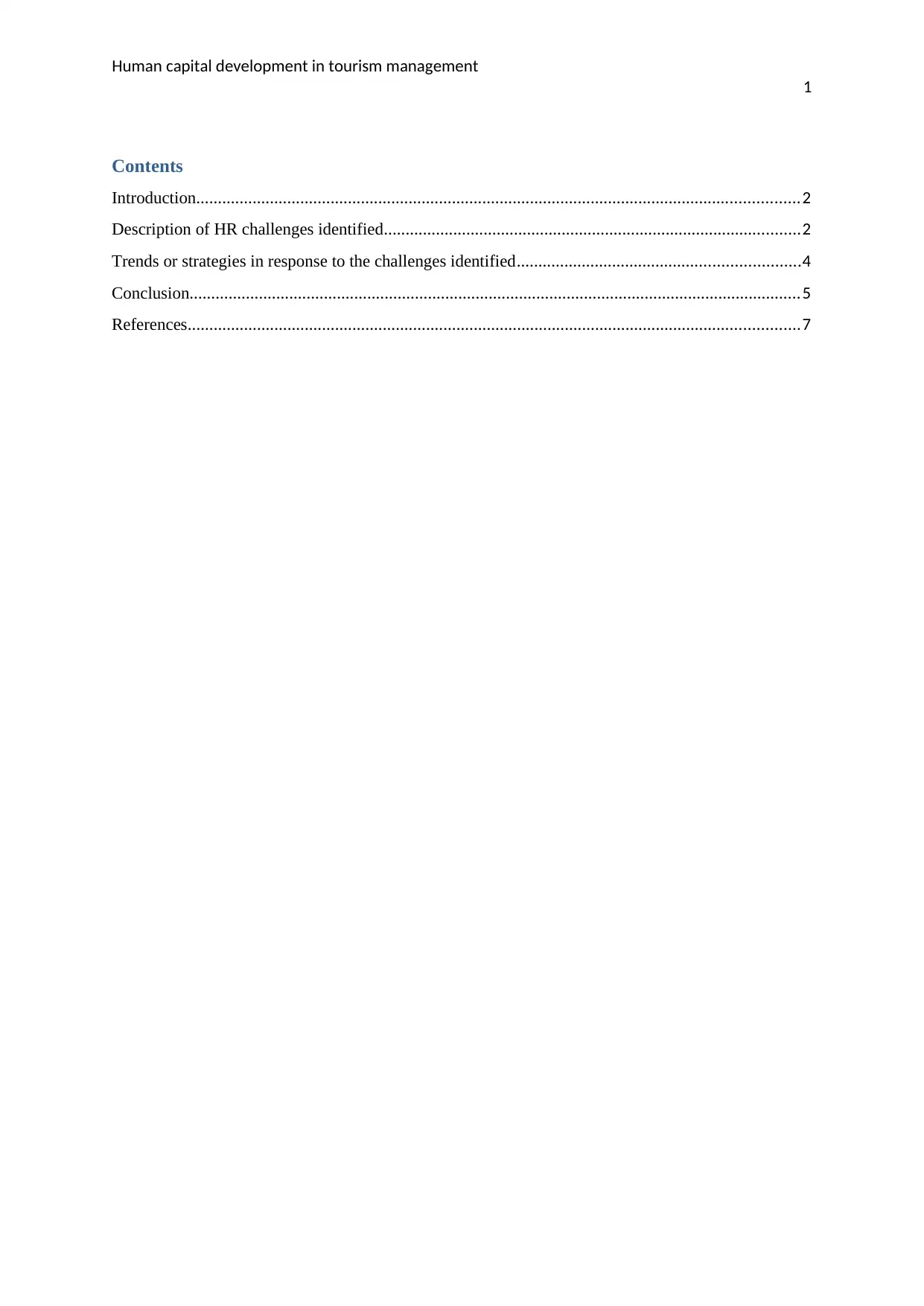
Human capital development in tourism management
1
Contents
Introduction...........................................................................................................................................2
Description of HR challenges identified................................................................................................2
Trends or strategies in response to the challenges identified.................................................................4
Conclusion.............................................................................................................................................5
References.............................................................................................................................................7
1
Contents
Introduction...........................................................................................................................................2
Description of HR challenges identified................................................................................................2
Trends or strategies in response to the challenges identified.................................................................4
Conclusion.............................................................................................................................................5
References.............................................................................................................................................7
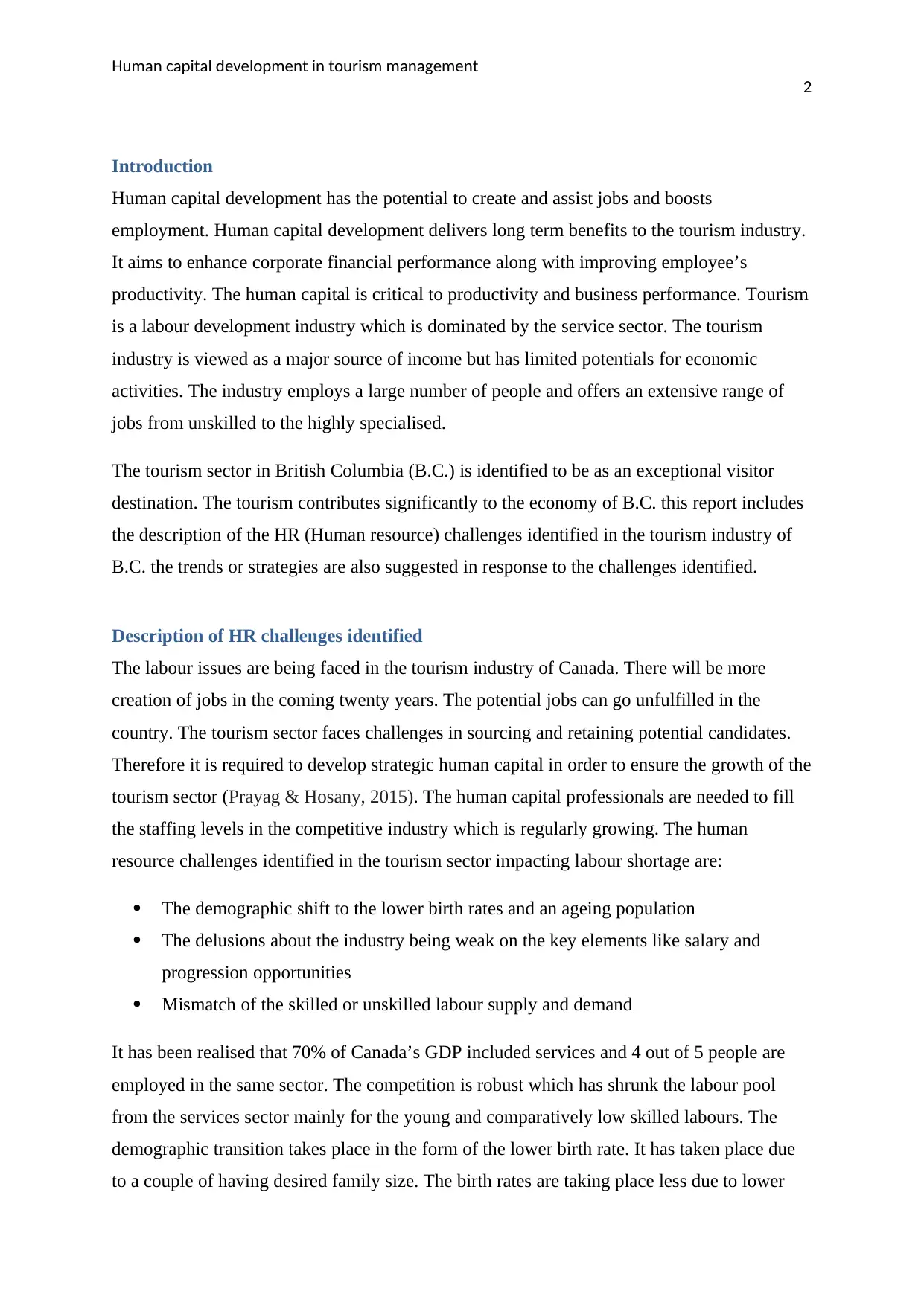
Human capital development in tourism management
2
Introduction
Human capital development has the potential to create and assist jobs and boosts
employment. Human capital development delivers long term benefits to the tourism industry.
It aims to enhance corporate financial performance along with improving employee’s
productivity. The human capital is critical to productivity and business performance. Tourism
is a labour development industry which is dominated by the service sector. The tourism
industry is viewed as a major source of income but has limited potentials for economic
activities. The industry employs a large number of people and offers an extensive range of
jobs from unskilled to the highly specialised.
The tourism sector in British Columbia (B.C.) is identified to be as an exceptional visitor
destination. The tourism contributes significantly to the economy of B.C. this report includes
the description of the HR (Human resource) challenges identified in the tourism industry of
B.C. the trends or strategies are also suggested in response to the challenges identified.
Description of HR challenges identified
The labour issues are being faced in the tourism industry of Canada. There will be more
creation of jobs in the coming twenty years. The potential jobs can go unfulfilled in the
country. The tourism sector faces challenges in sourcing and retaining potential candidates.
Therefore it is required to develop strategic human capital in order to ensure the growth of the
tourism sector (Prayag & Hosany, 2015). The human capital professionals are needed to fill
the staffing levels in the competitive industry which is regularly growing. The human
resource challenges identified in the tourism sector impacting labour shortage are:
The demographic shift to the lower birth rates and an ageing population
The delusions about the industry being weak on the key elements like salary and
progression opportunities
Mismatch of the skilled or unskilled labour supply and demand
It has been realised that 70% of Canada’s GDP included services and 4 out of 5 people are
employed in the same sector. The competition is robust which has shrunk the labour pool
from the services sector mainly for the young and comparatively low skilled labours. The
demographic transition takes place in the form of the lower birth rate. It has taken place due
to a couple of having desired family size. The birth rates are taking place less due to lower
2
Introduction
Human capital development has the potential to create and assist jobs and boosts
employment. Human capital development delivers long term benefits to the tourism industry.
It aims to enhance corporate financial performance along with improving employee’s
productivity. The human capital is critical to productivity and business performance. Tourism
is a labour development industry which is dominated by the service sector. The tourism
industry is viewed as a major source of income but has limited potentials for economic
activities. The industry employs a large number of people and offers an extensive range of
jobs from unskilled to the highly specialised.
The tourism sector in British Columbia (B.C.) is identified to be as an exceptional visitor
destination. The tourism contributes significantly to the economy of B.C. this report includes
the description of the HR (Human resource) challenges identified in the tourism industry of
B.C. the trends or strategies are also suggested in response to the challenges identified.
Description of HR challenges identified
The labour issues are being faced in the tourism industry of Canada. There will be more
creation of jobs in the coming twenty years. The potential jobs can go unfulfilled in the
country. The tourism sector faces challenges in sourcing and retaining potential candidates.
Therefore it is required to develop strategic human capital in order to ensure the growth of the
tourism sector (Prayag & Hosany, 2015). The human capital professionals are needed to fill
the staffing levels in the competitive industry which is regularly growing. The human
resource challenges identified in the tourism sector impacting labour shortage are:
The demographic shift to the lower birth rates and an ageing population
The delusions about the industry being weak on the key elements like salary and
progression opportunities
Mismatch of the skilled or unskilled labour supply and demand
It has been realised that 70% of Canada’s GDP included services and 4 out of 5 people are
employed in the same sector. The competition is robust which has shrunk the labour pool
from the services sector mainly for the young and comparatively low skilled labours. The
demographic transition takes place in the form of the lower birth rate. It has taken place due
to a couple of having desired family size. The birth rates are taking place less due to lower
⊘ This is a preview!⊘
Do you want full access?
Subscribe today to unlock all pages.

Trusted by 1+ million students worldwide
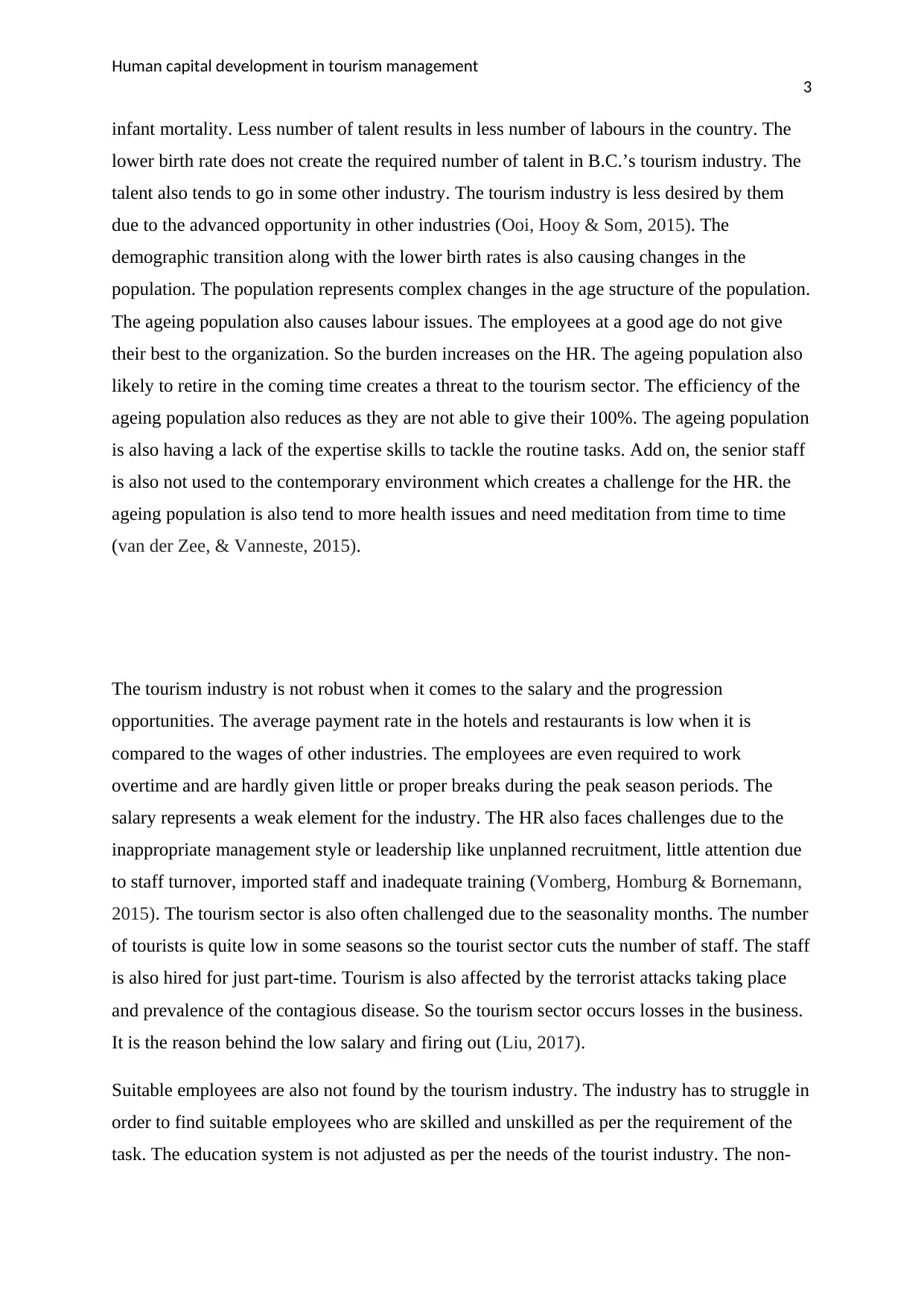
Human capital development in tourism management
3
infant mortality. Less number of talent results in less number of labours in the country. The
lower birth rate does not create the required number of talent in B.C.’s tourism industry. The
talent also tends to go in some other industry. The tourism industry is less desired by them
due to the advanced opportunity in other industries (Ooi, Hooy & Som, 2015). The
demographic transition along with the lower birth rates is also causing changes in the
population. The population represents complex changes in the age structure of the population.
The ageing population also causes labour issues. The employees at a good age do not give
their best to the organization. So the burden increases on the HR. The ageing population also
likely to retire in the coming time creates a threat to the tourism sector. The efficiency of the
ageing population also reduces as they are not able to give their 100%. The ageing population
is also having a lack of the expertise skills to tackle the routine tasks. Add on, the senior staff
is also not used to the contemporary environment which creates a challenge for the HR. the
ageing population is also tend to more health issues and need meditation from time to time
(van der Zee, & Vanneste, 2015).
The tourism industry is not robust when it comes to the salary and the progression
opportunities. The average payment rate in the hotels and restaurants is low when it is
compared to the wages of other industries. The employees are even required to work
overtime and are hardly given little or proper breaks during the peak season periods. The
salary represents a weak element for the industry. The HR also faces challenges due to the
inappropriate management style or leadership like unplanned recruitment, little attention due
to staff turnover, imported staff and inadequate training (Vomberg, Homburg & Bornemann,
2015). The tourism sector is also often challenged due to the seasonality months. The number
of tourists is quite low in some seasons so the tourist sector cuts the number of staff. The staff
is also hired for just part-time. Tourism is also affected by the terrorist attacks taking place
and prevalence of the contagious disease. So the tourism sector occurs losses in the business.
It is the reason behind the low salary and firing out (Liu, 2017).
Suitable employees are also not found by the tourism industry. The industry has to struggle in
order to find suitable employees who are skilled and unskilled as per the requirement of the
task. The education system is not adjusted as per the needs of the tourist industry. The non-
3
infant mortality. Less number of talent results in less number of labours in the country. The
lower birth rate does not create the required number of talent in B.C.’s tourism industry. The
talent also tends to go in some other industry. The tourism industry is less desired by them
due to the advanced opportunity in other industries (Ooi, Hooy & Som, 2015). The
demographic transition along with the lower birth rates is also causing changes in the
population. The population represents complex changes in the age structure of the population.
The ageing population also causes labour issues. The employees at a good age do not give
their best to the organization. So the burden increases on the HR. The ageing population also
likely to retire in the coming time creates a threat to the tourism sector. The efficiency of the
ageing population also reduces as they are not able to give their 100%. The ageing population
is also having a lack of the expertise skills to tackle the routine tasks. Add on, the senior staff
is also not used to the contemporary environment which creates a challenge for the HR. the
ageing population is also tend to more health issues and need meditation from time to time
(van der Zee, & Vanneste, 2015).
The tourism industry is not robust when it comes to the salary and the progression
opportunities. The average payment rate in the hotels and restaurants is low when it is
compared to the wages of other industries. The employees are even required to work
overtime and are hardly given little or proper breaks during the peak season periods. The
salary represents a weak element for the industry. The HR also faces challenges due to the
inappropriate management style or leadership like unplanned recruitment, little attention due
to staff turnover, imported staff and inadequate training (Vomberg, Homburg & Bornemann,
2015). The tourism sector is also often challenged due to the seasonality months. The number
of tourists is quite low in some seasons so the tourist sector cuts the number of staff. The staff
is also hired for just part-time. Tourism is also affected by the terrorist attacks taking place
and prevalence of the contagious disease. So the tourism sector occurs losses in the business.
It is the reason behind the low salary and firing out (Liu, 2017).
Suitable employees are also not found by the tourism industry. The industry has to struggle in
order to find suitable employees who are skilled and unskilled as per the requirement of the
task. The education system is not adjusted as per the needs of the tourist industry. The non-
Paraphrase This Document
Need a fresh take? Get an instant paraphrase of this document with our AI Paraphraser
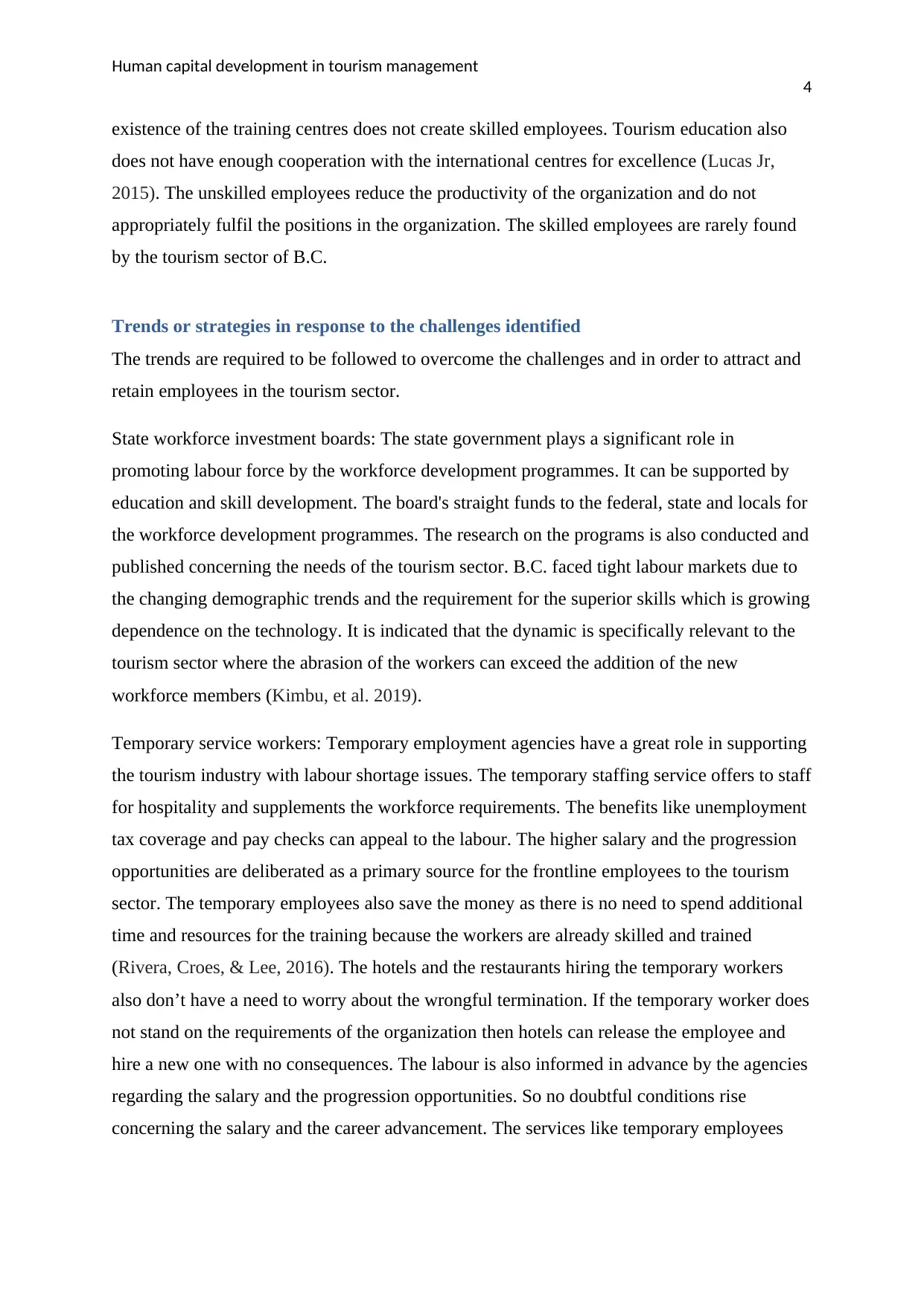
Human capital development in tourism management
4
existence of the training centres does not create skilled employees. Tourism education also
does not have enough cooperation with the international centres for excellence (Lucas Jr,
2015). The unskilled employees reduce the productivity of the organization and do not
appropriately fulfil the positions in the organization. The skilled employees are rarely found
by the tourism sector of B.C.
Trends or strategies in response to the challenges identified
The trends are required to be followed to overcome the challenges and in order to attract and
retain employees in the tourism sector.
State workforce investment boards: The state government plays a significant role in
promoting labour force by the workforce development programmes. It can be supported by
education and skill development. The board's straight funds to the federal, state and locals for
the workforce development programmes. The research on the programs is also conducted and
published concerning the needs of the tourism sector. B.C. faced tight labour markets due to
the changing demographic trends and the requirement for the superior skills which is growing
dependence on the technology. It is indicated that the dynamic is specifically relevant to the
tourism sector where the abrasion of the workers can exceed the addition of the new
workforce members (Kimbu, et al. 2019).
Temporary service workers: Temporary employment agencies have a great role in supporting
the tourism industry with labour shortage issues. The temporary staffing service offers to staff
for hospitality and supplements the workforce requirements. The benefits like unemployment
tax coverage and pay checks can appeal to the labour. The higher salary and the progression
opportunities are deliberated as a primary source for the frontline employees to the tourism
sector. The temporary employees also save the money as there is no need to spend additional
time and resources for the training because the workers are already skilled and trained
(Rivera, Croes, & Lee, 2016). The hotels and the restaurants hiring the temporary workers
also don’t have a need to worry about the wrongful termination. If the temporary worker does
not stand on the requirements of the organization then hotels can release the employee and
hire a new one with no consequences. The labour is also informed in advance by the agencies
regarding the salary and the progression opportunities. So no doubtful conditions rise
concerning the salary and the career advancement. The services like temporary employees
4
existence of the training centres does not create skilled employees. Tourism education also
does not have enough cooperation with the international centres for excellence (Lucas Jr,
2015). The unskilled employees reduce the productivity of the organization and do not
appropriately fulfil the positions in the organization. The skilled employees are rarely found
by the tourism sector of B.C.
Trends or strategies in response to the challenges identified
The trends are required to be followed to overcome the challenges and in order to attract and
retain employees in the tourism sector.
State workforce investment boards: The state government plays a significant role in
promoting labour force by the workforce development programmes. It can be supported by
education and skill development. The board's straight funds to the federal, state and locals for
the workforce development programmes. The research on the programs is also conducted and
published concerning the needs of the tourism sector. B.C. faced tight labour markets due to
the changing demographic trends and the requirement for the superior skills which is growing
dependence on the technology. It is indicated that the dynamic is specifically relevant to the
tourism sector where the abrasion of the workers can exceed the addition of the new
workforce members (Kimbu, et al. 2019).
Temporary service workers: Temporary employment agencies have a great role in supporting
the tourism industry with labour shortage issues. The temporary staffing service offers to staff
for hospitality and supplements the workforce requirements. The benefits like unemployment
tax coverage and pay checks can appeal to the labour. The higher salary and the progression
opportunities are deliberated as a primary source for the frontline employees to the tourism
sector. The temporary employees also save the money as there is no need to spend additional
time and resources for the training because the workers are already skilled and trained
(Rivera, Croes, & Lee, 2016). The hotels and the restaurants hiring the temporary workers
also don’t have a need to worry about the wrongful termination. If the temporary worker does
not stand on the requirements of the organization then hotels can release the employee and
hire a new one with no consequences. The labour is also informed in advance by the agencies
regarding the salary and the progression opportunities. So no doubtful conditions rise
concerning the salary and the career advancement. The services like temporary employees
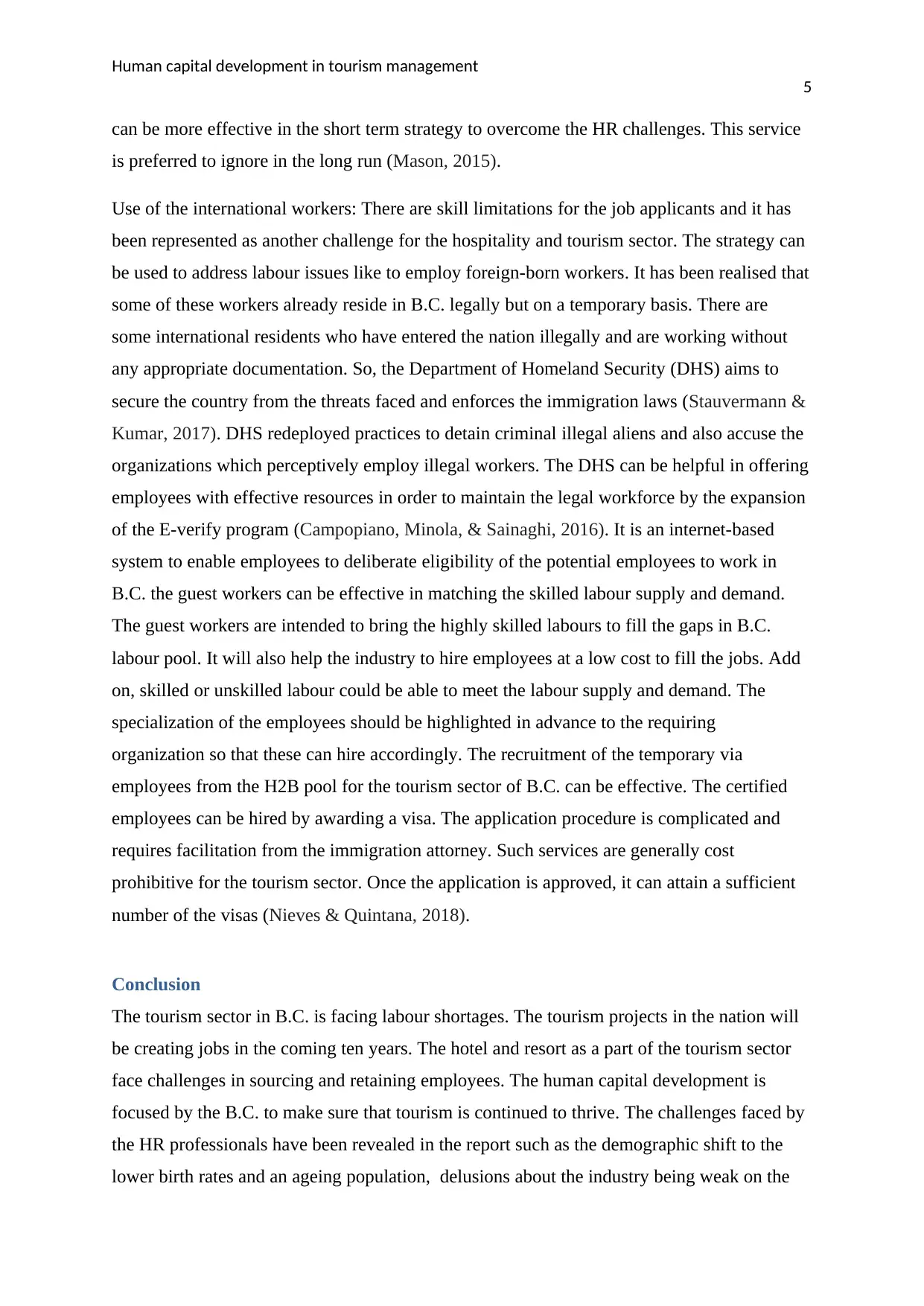
Human capital development in tourism management
5
can be more effective in the short term strategy to overcome the HR challenges. This service
is preferred to ignore in the long run (Mason, 2015).
Use of the international workers: There are skill limitations for the job applicants and it has
been represented as another challenge for the hospitality and tourism sector. The strategy can
be used to address labour issues like to employ foreign-born workers. It has been realised that
some of these workers already reside in B.C. legally but on a temporary basis. There are
some international residents who have entered the nation illegally and are working without
any appropriate documentation. So, the Department of Homeland Security (DHS) aims to
secure the country from the threats faced and enforces the immigration laws (Stauvermann &
Kumar, 2017). DHS redeployed practices to detain criminal illegal aliens and also accuse the
organizations which perceptively employ illegal workers. The DHS can be helpful in offering
employees with effective resources in order to maintain the legal workforce by the expansion
of the E-verify program (Campopiano, Minola, & Sainaghi, 2016). It is an internet-based
system to enable employees to deliberate eligibility of the potential employees to work in
B.C. the guest workers can be effective in matching the skilled labour supply and demand.
The guest workers are intended to bring the highly skilled labours to fill the gaps in B.C.
labour pool. It will also help the industry to hire employees at a low cost to fill the jobs. Add
on, skilled or unskilled labour could be able to meet the labour supply and demand. The
specialization of the employees should be highlighted in advance to the requiring
organization so that these can hire accordingly. The recruitment of the temporary via
employees from the H2B pool for the tourism sector of B.C. can be effective. The certified
employees can be hired by awarding a visa. The application procedure is complicated and
requires facilitation from the immigration attorney. Such services are generally cost
prohibitive for the tourism sector. Once the application is approved, it can attain a sufficient
number of the visas (Nieves & Quintana, 2018).
Conclusion
The tourism sector in B.C. is facing labour shortages. The tourism projects in the nation will
be creating jobs in the coming ten years. The hotel and resort as a part of the tourism sector
face challenges in sourcing and retaining employees. The human capital development is
focused by the B.C. to make sure that tourism is continued to thrive. The challenges faced by
the HR professionals have been revealed in the report such as the demographic shift to the
lower birth rates and an ageing population, delusions about the industry being weak on the
5
can be more effective in the short term strategy to overcome the HR challenges. This service
is preferred to ignore in the long run (Mason, 2015).
Use of the international workers: There are skill limitations for the job applicants and it has
been represented as another challenge for the hospitality and tourism sector. The strategy can
be used to address labour issues like to employ foreign-born workers. It has been realised that
some of these workers already reside in B.C. legally but on a temporary basis. There are
some international residents who have entered the nation illegally and are working without
any appropriate documentation. So, the Department of Homeland Security (DHS) aims to
secure the country from the threats faced and enforces the immigration laws (Stauvermann &
Kumar, 2017). DHS redeployed practices to detain criminal illegal aliens and also accuse the
organizations which perceptively employ illegal workers. The DHS can be helpful in offering
employees with effective resources in order to maintain the legal workforce by the expansion
of the E-verify program (Campopiano, Minola, & Sainaghi, 2016). It is an internet-based
system to enable employees to deliberate eligibility of the potential employees to work in
B.C. the guest workers can be effective in matching the skilled labour supply and demand.
The guest workers are intended to bring the highly skilled labours to fill the gaps in B.C.
labour pool. It will also help the industry to hire employees at a low cost to fill the jobs. Add
on, skilled or unskilled labour could be able to meet the labour supply and demand. The
specialization of the employees should be highlighted in advance to the requiring
organization so that these can hire accordingly. The recruitment of the temporary via
employees from the H2B pool for the tourism sector of B.C. can be effective. The certified
employees can be hired by awarding a visa. The application procedure is complicated and
requires facilitation from the immigration attorney. Such services are generally cost
prohibitive for the tourism sector. Once the application is approved, it can attain a sufficient
number of the visas (Nieves & Quintana, 2018).
Conclusion
The tourism sector in B.C. is facing labour shortages. The tourism projects in the nation will
be creating jobs in the coming ten years. The hotel and resort as a part of the tourism sector
face challenges in sourcing and retaining employees. The human capital development is
focused by the B.C. to make sure that tourism is continued to thrive. The challenges faced by
the HR professionals have been revealed in the report such as the demographic shift to the
lower birth rates and an ageing population, delusions about the industry being weak on the
⊘ This is a preview!⊘
Do you want full access?
Subscribe today to unlock all pages.

Trusted by 1+ million students worldwide
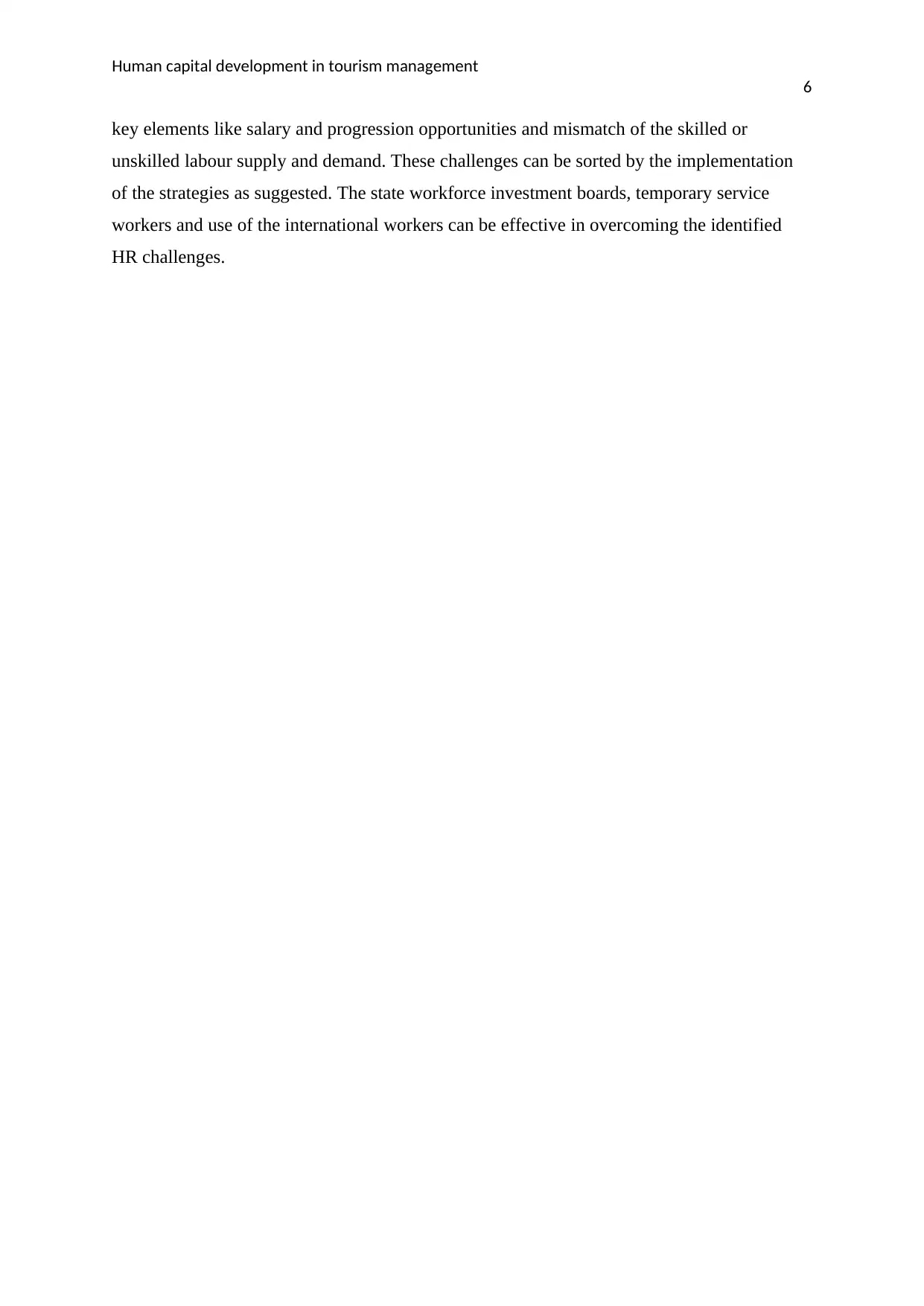
Human capital development in tourism management
6
key elements like salary and progression opportunities and mismatch of the skilled or
unskilled labour supply and demand. These challenges can be sorted by the implementation
of the strategies as suggested. The state workforce investment boards, temporary service
workers and use of the international workers can be effective in overcoming the identified
HR challenges.
6
key elements like salary and progression opportunities and mismatch of the skilled or
unskilled labour supply and demand. These challenges can be sorted by the implementation
of the strategies as suggested. The state workforce investment boards, temporary service
workers and use of the international workers can be effective in overcoming the identified
HR challenges.
Paraphrase This Document
Need a fresh take? Get an instant paraphrase of this document with our AI Paraphraser
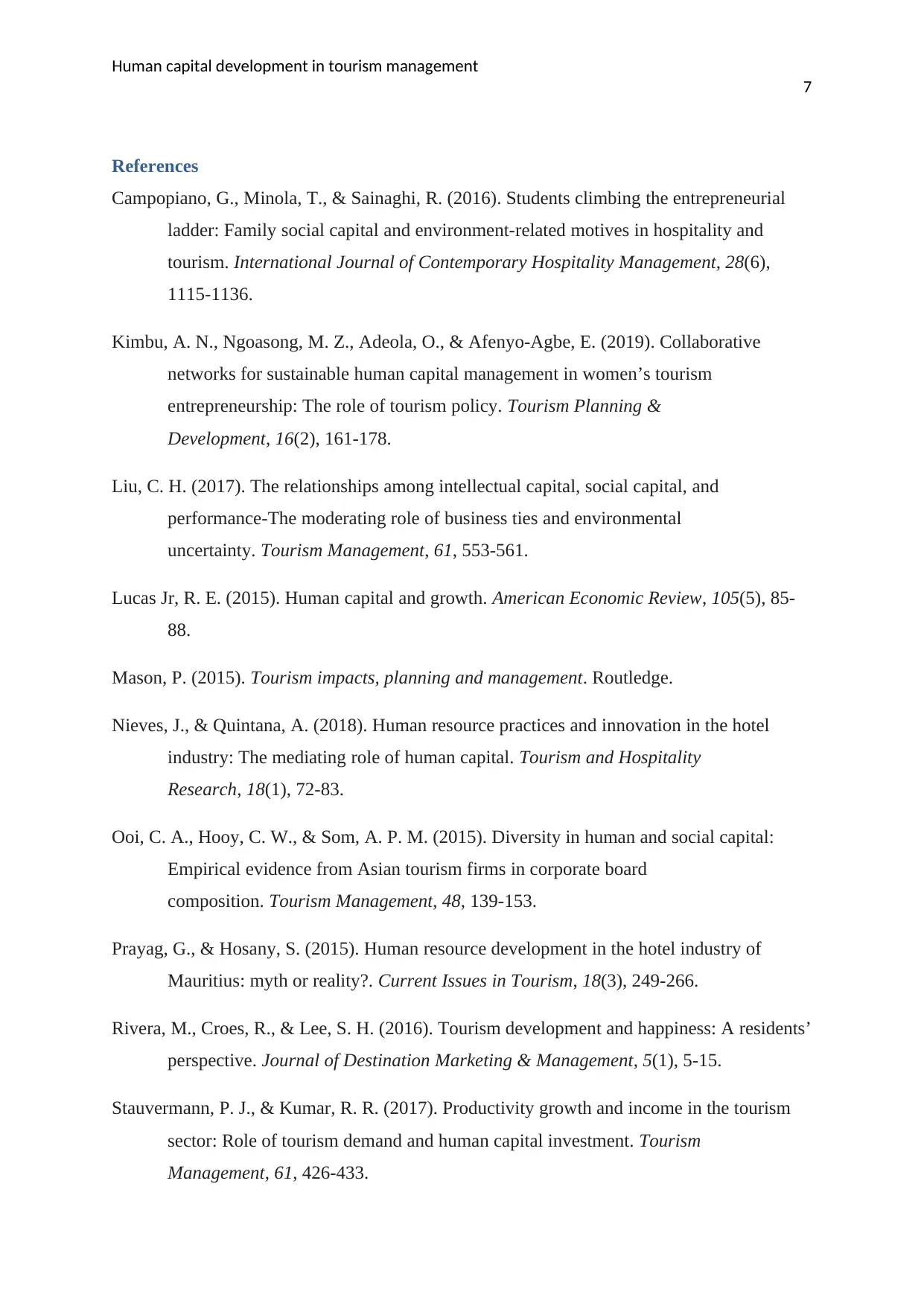
Human capital development in tourism management
7
References
Campopiano, G., Minola, T., & Sainaghi, R. (2016). Students climbing the entrepreneurial
ladder: Family social capital and environment-related motives in hospitality and
tourism. International Journal of Contemporary Hospitality Management, 28(6),
1115-1136.
Kimbu, A. N., Ngoasong, M. Z., Adeola, O., & Afenyo-Agbe, E. (2019). Collaborative
networks for sustainable human capital management in women’s tourism
entrepreneurship: The role of tourism policy. Tourism Planning &
Development, 16(2), 161-178.
Liu, C. H. (2017). The relationships among intellectual capital, social capital, and
performance-The moderating role of business ties and environmental
uncertainty. Tourism Management, 61, 553-561.
Lucas Jr, R. E. (2015). Human capital and growth. American Economic Review, 105(5), 85-
88.
Mason, P. (2015). Tourism impacts, planning and management. Routledge.
Nieves, J., & Quintana, A. (2018). Human resource practices and innovation in the hotel
industry: The mediating role of human capital. Tourism and Hospitality
Research, 18(1), 72-83.
Ooi, C. A., Hooy, C. W., & Som, A. P. M. (2015). Diversity in human and social capital:
Empirical evidence from Asian tourism firms in corporate board
composition. Tourism Management, 48, 139-153.
Prayag, G., & Hosany, S. (2015). Human resource development in the hotel industry of
Mauritius: myth or reality?. Current Issues in Tourism, 18(3), 249-266.
Rivera, M., Croes, R., & Lee, S. H. (2016). Tourism development and happiness: A residents’
perspective. Journal of Destination Marketing & Management, 5(1), 5-15.
Stauvermann, P. J., & Kumar, R. R. (2017). Productivity growth and income in the tourism
sector: Role of tourism demand and human capital investment. Tourism
Management, 61, 426-433.
7
References
Campopiano, G., Minola, T., & Sainaghi, R. (2016). Students climbing the entrepreneurial
ladder: Family social capital and environment-related motives in hospitality and
tourism. International Journal of Contemporary Hospitality Management, 28(6),
1115-1136.
Kimbu, A. N., Ngoasong, M. Z., Adeola, O., & Afenyo-Agbe, E. (2019). Collaborative
networks for sustainable human capital management in women’s tourism
entrepreneurship: The role of tourism policy. Tourism Planning &
Development, 16(2), 161-178.
Liu, C. H. (2017). The relationships among intellectual capital, social capital, and
performance-The moderating role of business ties and environmental
uncertainty. Tourism Management, 61, 553-561.
Lucas Jr, R. E. (2015). Human capital and growth. American Economic Review, 105(5), 85-
88.
Mason, P. (2015). Tourism impacts, planning and management. Routledge.
Nieves, J., & Quintana, A. (2018). Human resource practices and innovation in the hotel
industry: The mediating role of human capital. Tourism and Hospitality
Research, 18(1), 72-83.
Ooi, C. A., Hooy, C. W., & Som, A. P. M. (2015). Diversity in human and social capital:
Empirical evidence from Asian tourism firms in corporate board
composition. Tourism Management, 48, 139-153.
Prayag, G., & Hosany, S. (2015). Human resource development in the hotel industry of
Mauritius: myth or reality?. Current Issues in Tourism, 18(3), 249-266.
Rivera, M., Croes, R., & Lee, S. H. (2016). Tourism development and happiness: A residents’
perspective. Journal of Destination Marketing & Management, 5(1), 5-15.
Stauvermann, P. J., & Kumar, R. R. (2017). Productivity growth and income in the tourism
sector: Role of tourism demand and human capital investment. Tourism
Management, 61, 426-433.
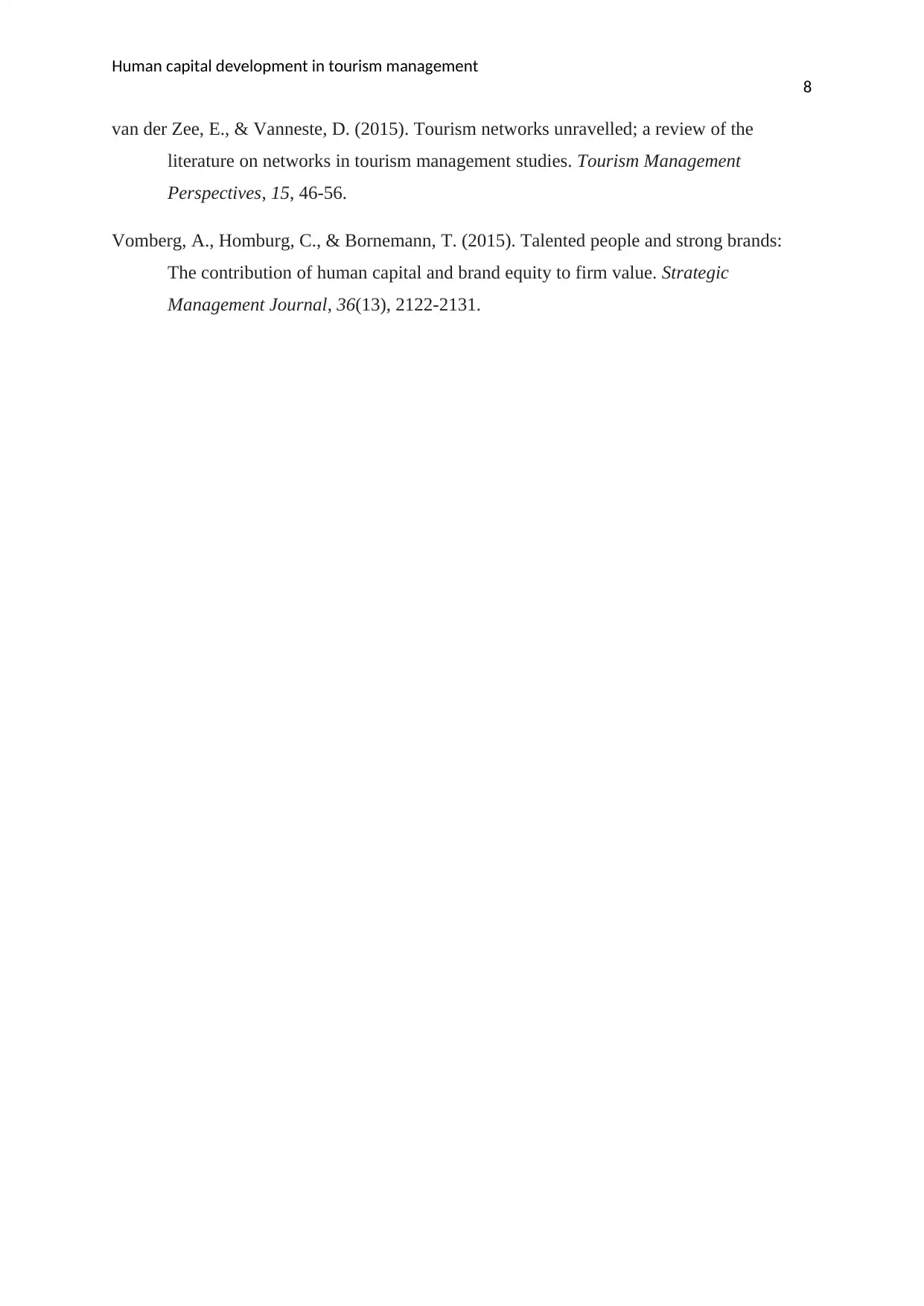
Human capital development in tourism management
8
van der Zee, E., & Vanneste, D. (2015). Tourism networks unravelled; a review of the
literature on networks in tourism management studies. Tourism Management
Perspectives, 15, 46-56.
Vomberg, A., Homburg, C., & Bornemann, T. (2015). Talented people and strong brands:
The contribution of human capital and brand equity to firm value. Strategic
Management Journal, 36(13), 2122-2131.
8
van der Zee, E., & Vanneste, D. (2015). Tourism networks unravelled; a review of the
literature on networks in tourism management studies. Tourism Management
Perspectives, 15, 46-56.
Vomberg, A., Homburg, C., & Bornemann, T. (2015). Talented people and strong brands:
The contribution of human capital and brand equity to firm value. Strategic
Management Journal, 36(13), 2122-2131.
⊘ This is a preview!⊘
Do you want full access?
Subscribe today to unlock all pages.

Trusted by 1+ million students worldwide
1 out of 9
Related Documents
Your All-in-One AI-Powered Toolkit for Academic Success.
+13062052269
info@desklib.com
Available 24*7 on WhatsApp / Email
![[object Object]](/_next/static/media/star-bottom.7253800d.svg)
Unlock your academic potential
Copyright © 2020–2025 A2Z Services. All Rights Reserved. Developed and managed by ZUCOL.





